2017 Penny Coin Value: How Much Is It Worth?
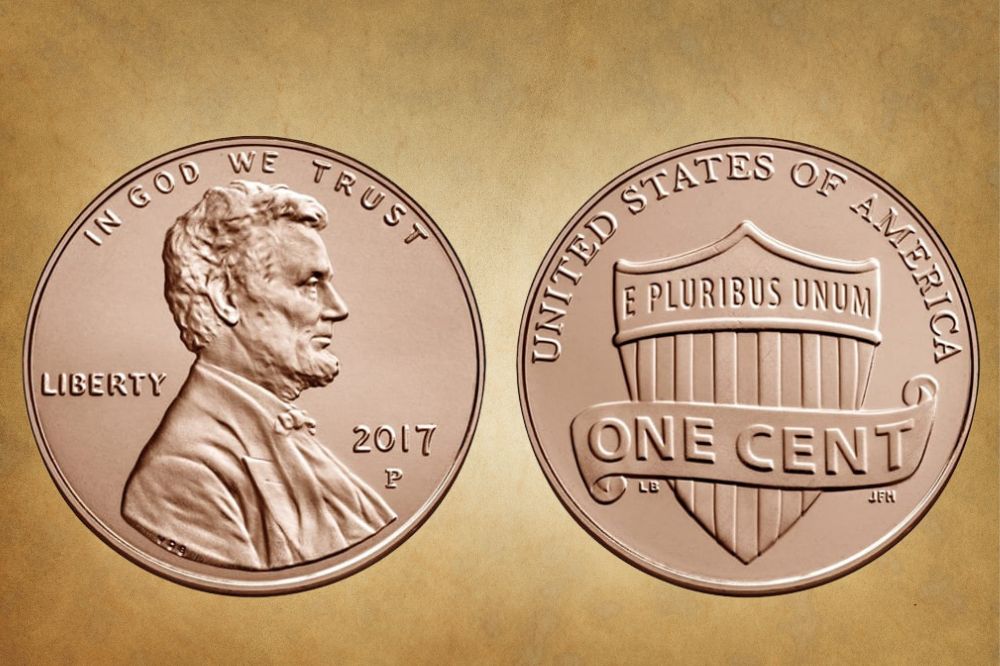
Modern coins don’t usually get much attention, but the 2017 Penny is different. It was coined during the 225th Anniversary of the Philadelphia Mint, so it’s the only Lincoln Cent with a P Mint Mark on it. Let’s take a closer look at this penny to assess the true 2017 Penny Value.
2017 Penny Value Chart |
||
| Mint Mark | High Mint State (MS 65) | Proof (PR / PF 65) |
| 2017-S Penny Value | No Business Strike
S-Pennies |
$4.52 |
| 2017-P Penny Value | $0.33 | No-P Proofs |
| 2017-D Penny Value | $0.33 | No D-Proofs |
| 2017-S Enhanced Uncirculated Penny Value | $19 | No Enhanced
Uncirculated Proofs |
2017 Penny Value Guide
Apart from the 1943 and 1944 War Pennies or Steelies, Lincoln Cents have a distinct copper hue. So in addition to quality and clarity, these pennies are color-graded RD for red, RB for reddish-brown, or BN for brown, with RD being the highest and most expensive grade. Mint marks can also add value to a coin, so let’s look at the coinage locations of the 2017 Pennies.
2017-P No Mint Mark Penny Value
In 2017, the Philadelphia Mint made 4,361,220,000 Pennies. And notably, 2017 was the only year when pennies had a P Mint Mark. This gesture commemorated the 225th Anniversary of the Philadelphia Mint, and the P Mint Mark was taken off pennies from 2018 onward. A 2017 MS 70 BN – perfect grade – was $66 in December 2020, but an MS 68 RD went for $712.80.
A 2017 RB coin graded Genuine by NGC was $55 in May 2018, and it was also sold on eBay. MS 70 is the highest possible grade for a coin while PO1 is the lowest. Oddly, a PO1 RD coin sold for $4,500 on eBay in July 2018. That said, eBay sales are set by public interest, so price guides give more accurate evaluations. PCGS estimates the value of an MS 68 RD as $475.
2017-D Penny Value
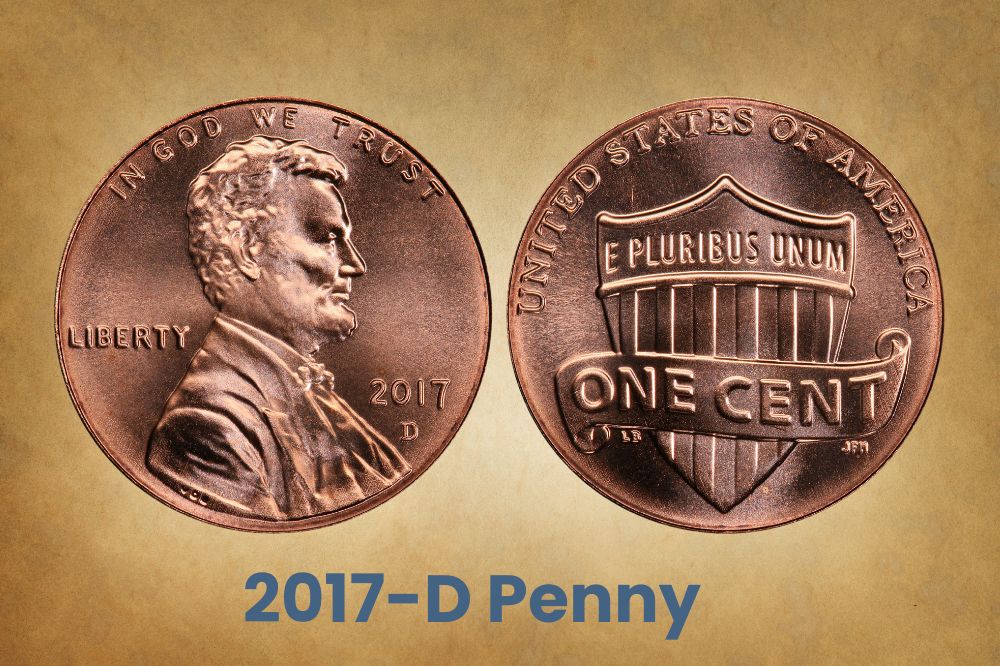
In 2017, the Denver Mint coined 4,272,800,000 pennies bearing the D Mint Mark. Coin prices are largely driven by sales dates, with anniversary years attaining high premiums. In 2021, an MS 66 BN was a mere $19 on eBay. But PCGS has only graded 5 coins at MS 68 RD, and that rarity can drive prices higher. The current auction record is $1,595, set in July 2021.
2017-S Proof Penny Value
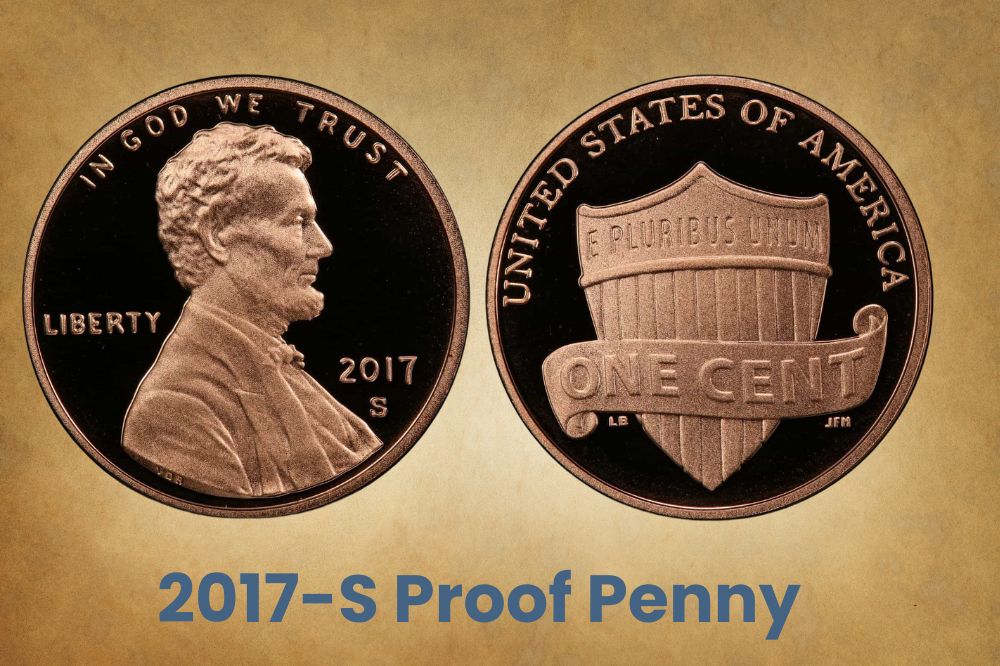
After 1965, the San Francisco Mint made proof coins exclusively, and in 2017, it produced 979,498 Proof Pennies with the S Mint Mark. Proof coins are made to ensure die accuracy and a copy is kept in the archives. Some are sent to museums, and the rest are sold to collectors. The frosted portions of the coin are either pickled with acid or computer lasers.
For acid-treated coins, the frosting would fade after a while, so the first few coins show far deeper contrast than the rest and are graded Deep Cameo (DCAM) by PCGS or Ultra Cameo by NGC. The grade below that is Cameo, followed by regular proofs. Usually, only 50 to 100 acid-washed coins come out as DCAMs. But laser-frosted coins don’t fade as dies get older.
However, these proof coins can degrade if they’re circulated, so you can find samples in grades as low as brown. And sometimes, these coins are self-graded rather than sending them to assessors like NGC or PCGS, so that could be part of it. As a point of interest, the computerized laser process began in 1971 and the first Reverse Proofs were minted in 2006.
A PR 70 BN was $89 in July 2018 but a year later, a PR 70 RB was down to $55 in May 2019. Then in February 2021, a PR 70 RD was $255. A PR 70 DCAM was $95 in July 2018 when the coin was only a year old. These are all eBay sales so they bounce around a lot. PCGS price guides are more reliable, but they only place PR 70 DCAMs at $35. They’ve seen almost 600.
2017-S Enhanced Uncirculated Penny Value
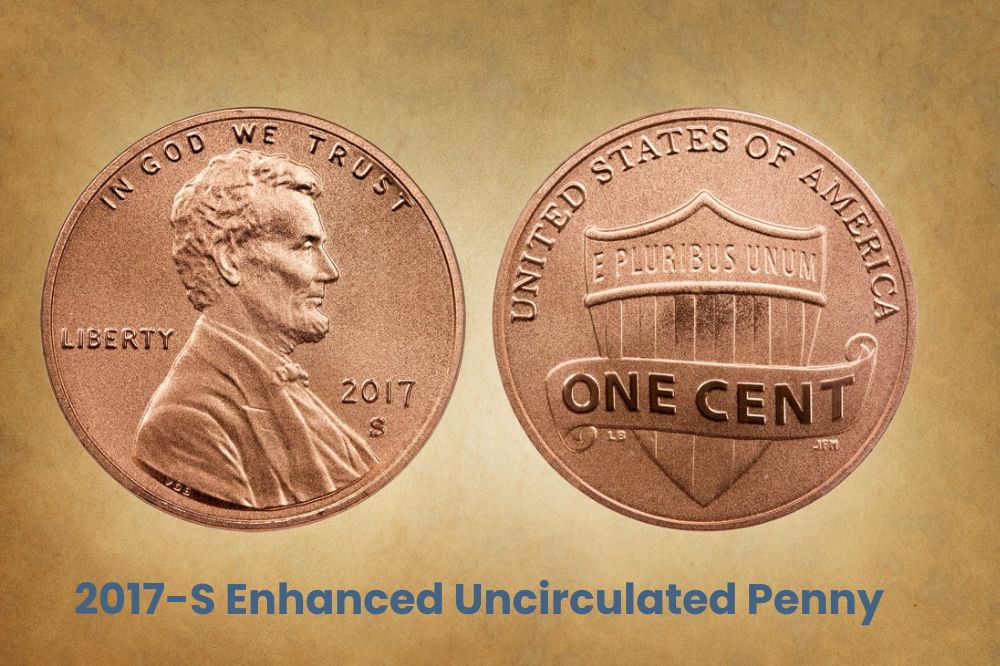
Uncirculated Sets are coins that have a satin-finish P, D, and S coin from each circulating denomination. They’re sometimes called PDS sets, and unlike proof coins or Special Mint Sets (SMS), Uncirculated Sets don’t use burnished planchets or polished dies. They’re just business strike coins with extra clarity and superior shine, so they’re picked out by mint staff.
Before the regular coins are sent into circulation, some high-grade samples are hand-selected from the coin hoppers and packaged separately. They’ll be sold as PDS Uncirculated Sets at premium prices before they get damaged by everyday use. These sparkly coins are sometimes graded as BU for Brilliant Uncirculated, PL for Proof-Like, or DPL for Deep-Proof-Like.
Another grade you might spot for these coins is SP which means Specimen. It was used for mirror-like coins minted from 1792 to 1816, except they didn’t have closed collars so their thickness wasn’t standardized. Coins like these would later be classified as proofs. But for NGC, an SP is a hybrid of proofs (PF) and mint states (MS), exhibiting both their features.
Recognizing the 2017 Enhanced Uncirculated Set
Enhanced Uncirculated Sets were released in 2017 to mark the 225th Philadelphia Mint Anniversary. Each set had ten coins that had been given a commemorative finish for the occasion. The coins all had the S Mint Mark and comprised a Sequoyah Dollar, a JFK Half Dollar, a Jefferson Nickel, a Roosevelt Dime, 5 National Park Quarters, and a Shield Cent.
But what exactly is this enhanced uncirculated finish? The coins were treated with the same computerized lasers that frost modern proof coins, but they used unburnished planchets and unpolished dies. Both their fields and devices are frosted, but the date, mottos, and legends have mirror-like finishes except the designers’ initials and the E Pluribus Unum inside the shield.
In 2017, the San Francisco Mint made 223,210 Enhanced Uncirculated Proof Pennies. Since this coin is so young, it’s easy to find samples in the top-most grade of PR 70. Accessibility keeps the prices low, and the record price for an SP 70 BN was just $50 in May 2020. A couple of years back, an SP 70 RB was $302 in August 2018 while an SP 70 RD sold for $190.
Summary of US Coin Strikes |
|
| Coin Strike Category | Description |
| Business Strike | Unburnished planchet, multiple strikes, no special finish |
| Uncirculated Set | Unburnished planchet, multiple strikes, natural satin-finish |
| Matte Proof | Sandblasted for matte grainy finish, multiple strikes, packaged in sulfur-infused tissue paper |
| Mirror-Like Proof | Burnished planchet, polished die, mirror-like field, either acid-frosted or laser-frosted device, multiple strikes |
| Reverse Proof | Burnished planchet, polished die, mirror-like device, laser-frosted field, multiple strikes |
| Special Mint Set (SMS) | Unburnished planchet, polished die, acid-frosted device, mirror-like field, only one strike at higher pressure settings |
| Enhanced Uncirculated Set | Unburnished planchet, unpolished die, laser-frosted device, laser-frosted field, mirror-like legends, mottos, and date |
Related Posts: 16 Most Valuable Wheat Penny Errors
2017 Penny Errors
Errors can add significant value to any coin, and they often happen due to striking mistakes. When a coin is being designed, the artist makes an 8” model of rubber, plaster, and epoxy that gets reduced at the mint using an aptly named reducing machine. This process takes several days to produce a steel master hub. The master hub makes a series of master dies.
The master dies make working hubs which later make working dies, complete with the mint mark. For reference, the mint mark was added by hand until 1989 but is now machined onto the working die. These working dies then strike planchets to make coins. Each of these steps requires multiple strikes (except for SMS coins) and the metal sometimes moves mid-strike.
This can lead to mint errors like doubling, tripling, or misalignment. Or broadstrikes, when the three-piece detachable mold that forms the coin collar separates too soon. Or strike-throughs when a foreign object sneaks between the die and the planchet. Or a coin might be stamped onto a planchet intended for a different denomination or date. Let’s explore a few.
2017-P Penny DDO Error
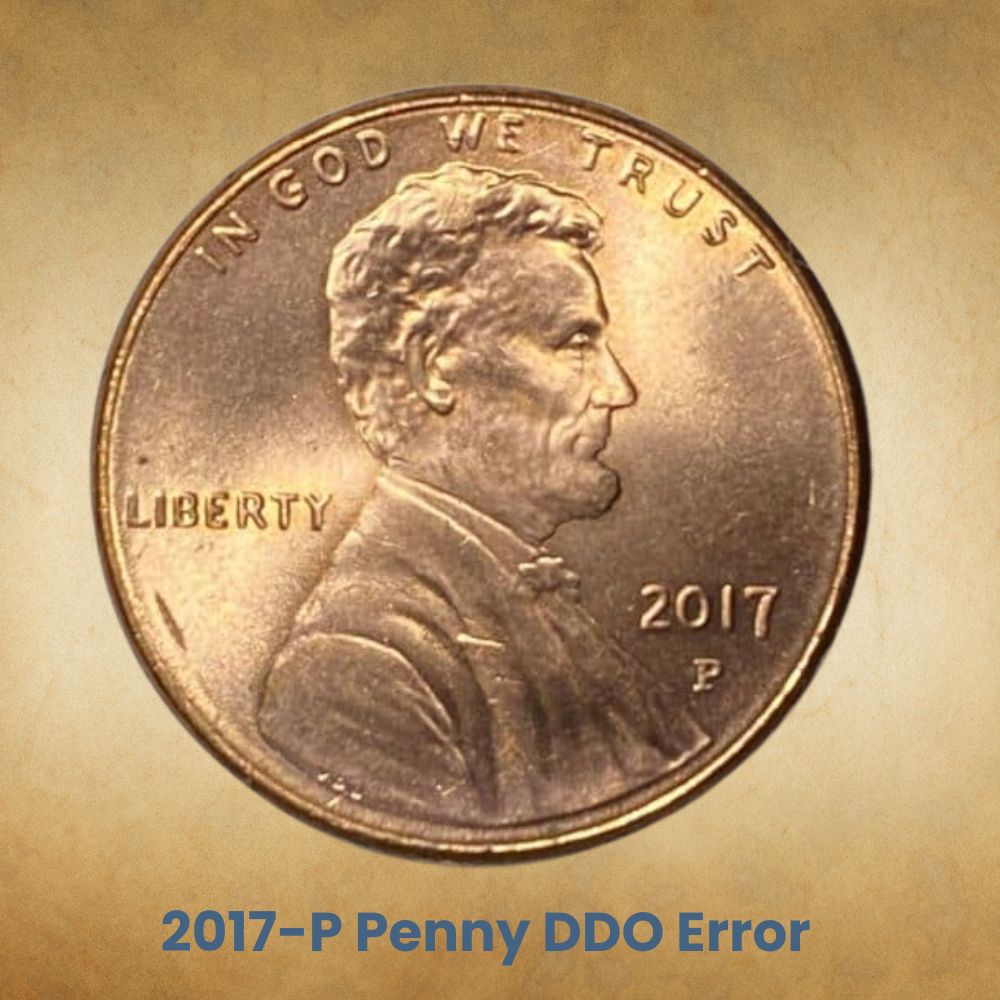
DDO means doubled-die obverse. It happens when the die shifts between hub strikes so the second impression lands at a slightly different spot. This flaw is then reproduced on every coin that die strikes, creating a variety. Thousands of coins might get this identical error before it gets spotted and corrected. But it’s not a valuable error – less than $10 in MS 65.
2017-P Penny Reverse Die Break Error
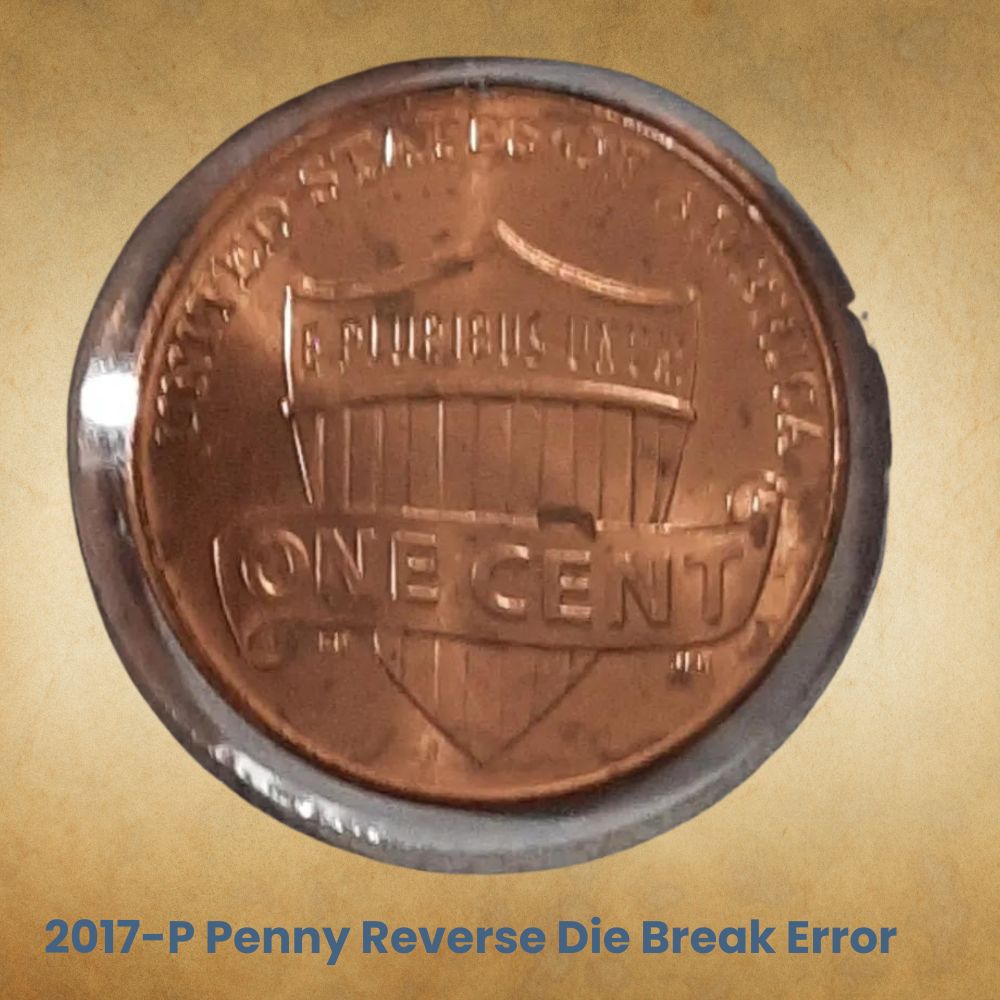
Die breaks are sometimes called cud errors. They happen because as dies get older, they develop cracks or slashes called cuds that get transferred onto coins. This die error is easy to spot. It appears as a slanted slash that runs from the E in States down to the top of the Union Shield, and you can see it without a microscope. In MS 66 RD, it’s offered on eBay for $270.
2017-P Penny Off-Centre Error
An off-center error happens when the planchet shifts before the first die strike. This leaves a portion of the planchet blank when the coin exits the press, and the size of the off-center can dictate the price of the coin. This 2017-P Penny only has a small misalignment on the lower right obverse and upper right reverse. It’s graded MS 64 RD and the asking price was $300.
2017-P Penny Struck Thru Grease Reverse
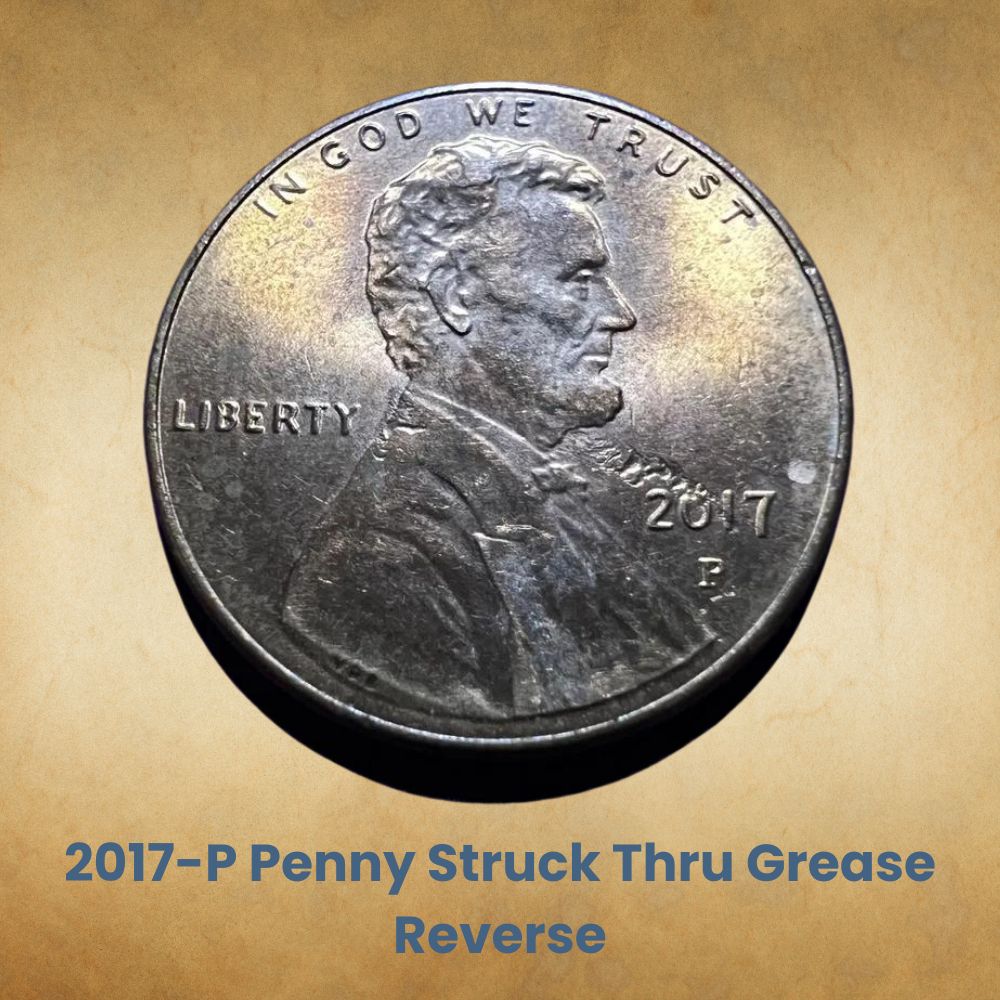
Planchets are often heated before they enter the coin press. This softens the metal and helps it take the design better. But sometimes a contaminant slips between the planchet and the die. This foreign item might get stuck on the coin, leave a silhouette, or blur the words and images. This MS 64 RD cent was struck through with grease, and the asking price was $190.
2017 Penny Floating Head Error
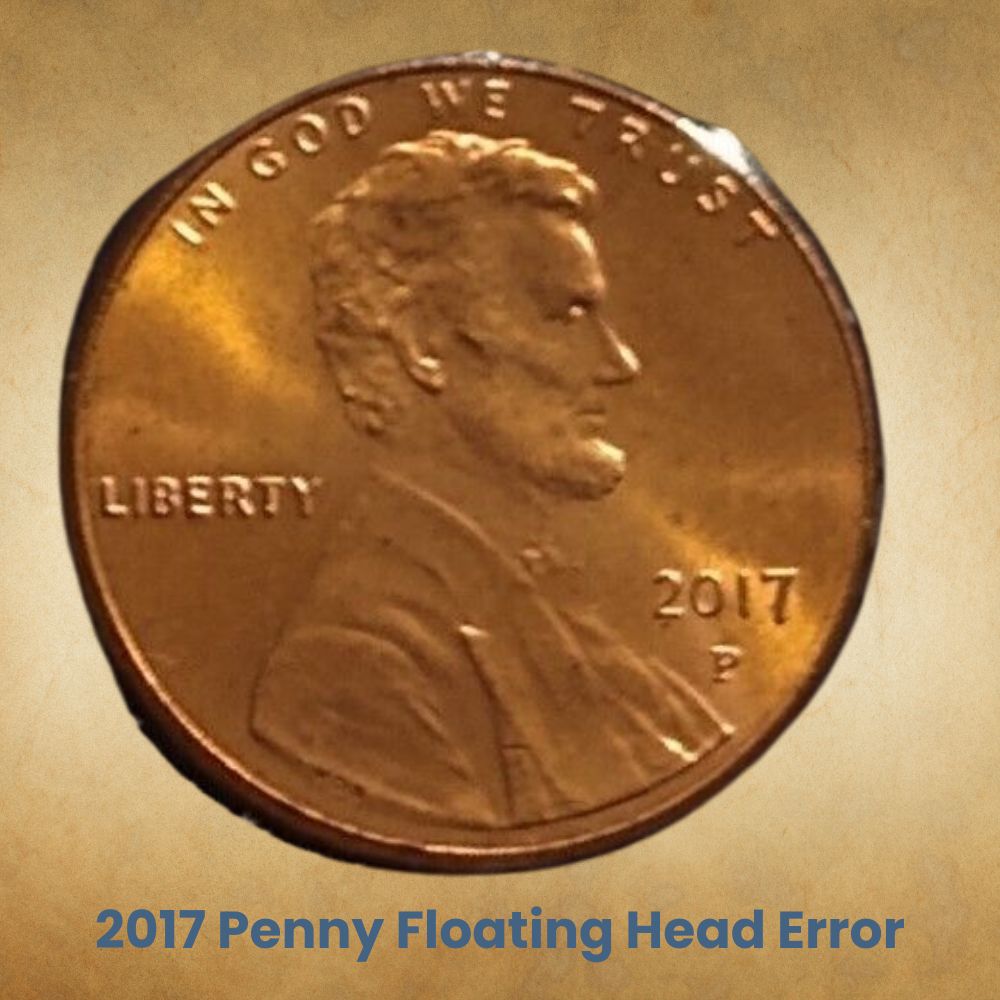
This isn’t exactly an error coin since it didn’t happen at the mint so it isn’t listed in the books. But it’s an unusual-looking coin and a fun one to have. On the coin, Lincoln’s shirt collar has worn off in circulation since lots of people hold the center of the coin while handling it, so the coin appears to have a floating head. It only sold for $12, but it could go for more on eBay.
2017 Penny Obverse Die Clash Error
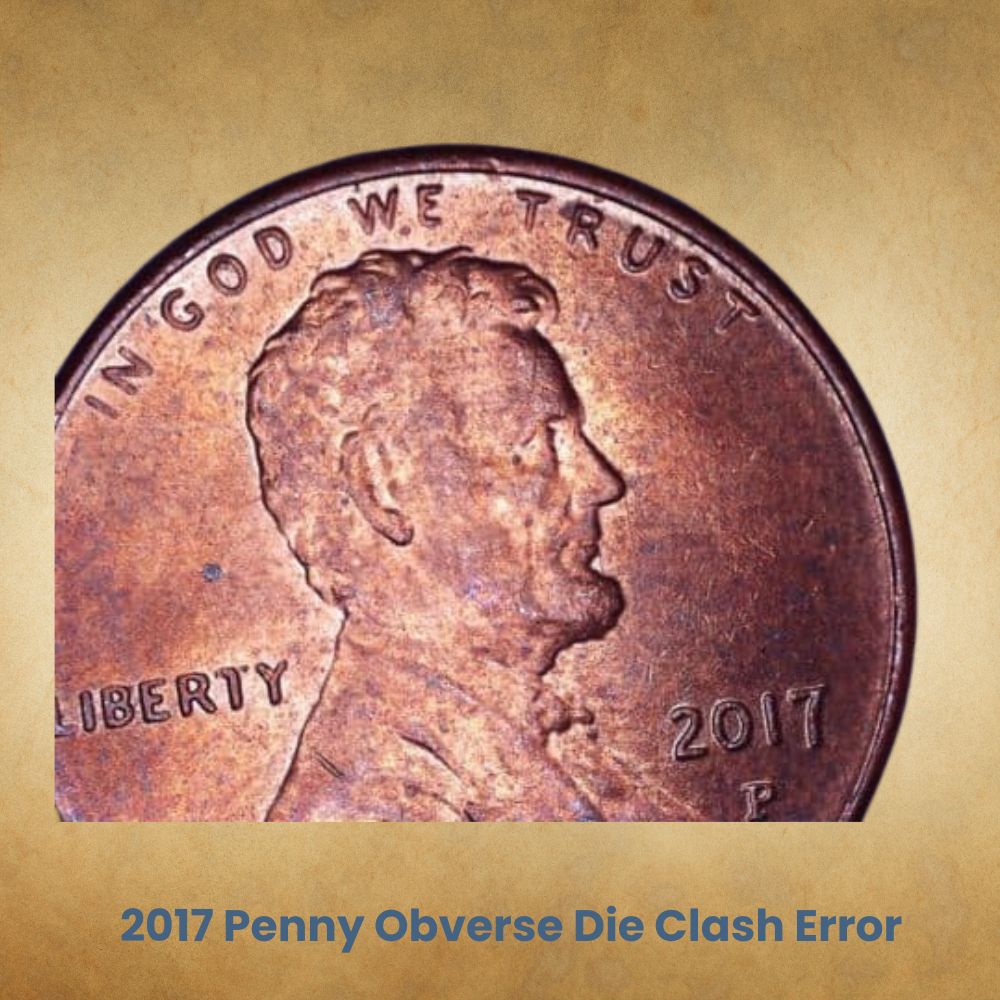
When a coin is in the press, the reverse die and obverse die hit the planchet at the same time. And if the coin feeder is too slow, the two dies will smash into each other and some of their details may transfer onto each other. The next coin might then get traces of reverse details on the obverse and vice versa. This coin has shield stripes on the obverse. In MS 65, that’s $150.
2017 Penny Bonded Pair Error
Sometimes, a planchet gets jammed inside the coin hopper, and this can cause bonded pairs. Since the top coin blocks the one below it, the design might be blurry on the lower coin. Or the two coins might get stuck together and form one thicker coin. Or you might get a mated pair that has two stamped sides and two blank ones. This bonded penny pair was $4,500.
Related Posts: 19 Most Valuable Lincoln Memorial Penny Worth Money
History of the 2017 Penny
Abraham Lincoln was the first person to be honored on a US coin. This began in 1909, a hundred years after his birth, and was done under intense public pressure. It was also the first penny to have In God We Trust, although this was more of a coin correction than a legal mandate. It was done to fill extra space at the top of the coin after a flawed edit at the mint.
Before this, coins bore symbolic images that depicted Lady Liberty because some of our Founding Fathers – including George Washington and Benjamin Franklin – vetoed the colonial practice of putting kings, queens, and other leaders on coins. But after Lincoln, both Washington and Franklin were placed on US coins, along with later American Presidents.
The first Lincoln Penny was designed by Victor David Brenner as part of President Theodore Roosevelt’s coin beautification project. Brenner’s heads design is still used, so all pennies are technically Lincoln Cents. But the tails design has changed several times, so these coins are sub-categorized by the visuals on the back, including the Wheat, Memorial, and Shield Cent.
The Shield Cent was designed by Lyndall Bass and Joseph Francis Menna. Menna worked at the mint from 2005 as its first digital engraver, and he became Chief Mint Engraver in 2019. And Bass is only the second woman ever accredited for designing a US coin. The first woman was Laura Gardin Fraser for the 2022 American Women Quarter and $5 Washington Gold.
The 2017 Penny is a Shield Cent, minted from 2010 to date. It has a Union Shield with 13 stripes to represent the first 13 states that joined the union and/or ratified the constitution. On earlier coins, an extra symbol (e.g. a star, stripe, arrow) was added each time a new state joined, but after 16 states, this proved impractical, so 13 symbols became the mint standard.
Related Posts: 19 Most Valuable Wheat Penny Worth Money
how to identify 2017 Penny?
Coins are typically described using a handful of technical terms, so let’s go over some of the jargon. Coins are minted by striking designs on blank discs called planchets. The planchets come to the mint as a coiled metal sheet that’s flattened and fed into a blanking machine. The heads side of a coin is called its obverse and the tails side is referred to as the reverse.
The slimmest sides are called edges. The images on a coin e.g. statues, birds, portraits, etc. are called devices while the words are legends or mottos. The background of the coin is called the field. Proof coins have a mirror-like field and a frosted device while reverse proofs have a frosted field and mirrored devices. From 1909 to 1917, the mint made matte proofs instead.
They were sandblasted to give the whole coin surface a grainy matte finish. Special Mint Sets (SMS) are mirror-like, but they’re only struck once at high pressure while all other coins get at least two strikes. Striking is the process of hammering planchets, dies, or hubs in a coin press to imprint the coin’s designs on the metal. Let’s discuss the features of the 2017 Penny.
The Obverse of the 2017 Penny
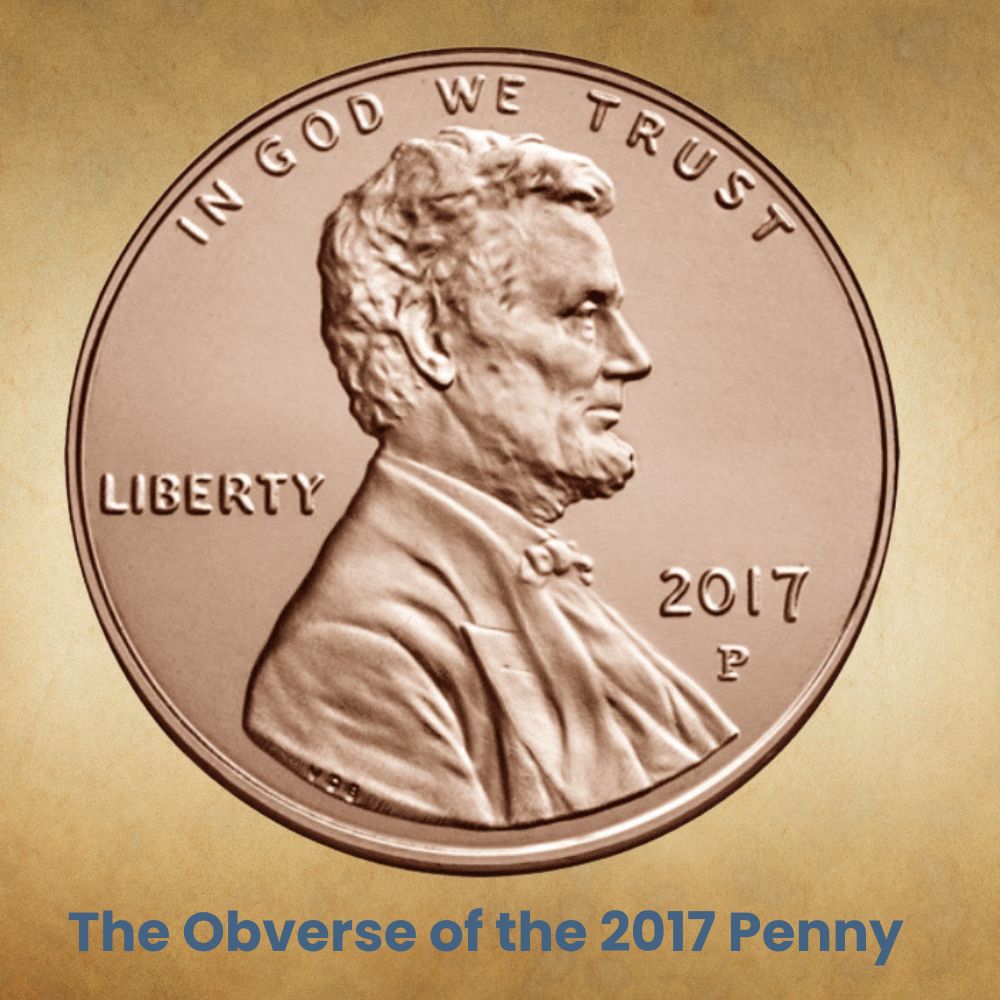
The obverse (heads side) of the 2017 Penny has maintained its original design since 1909. It shows Abraham Lincoln in profile facing right, with In God We Trust above his head. The mint mark and date are on the right at chest level, while the legend Liberty is on the left side, behind his back. The designer’s initials, VDB, are on the left shoulder cut-off of the portrait.
The Reverse of the 2017 Penny
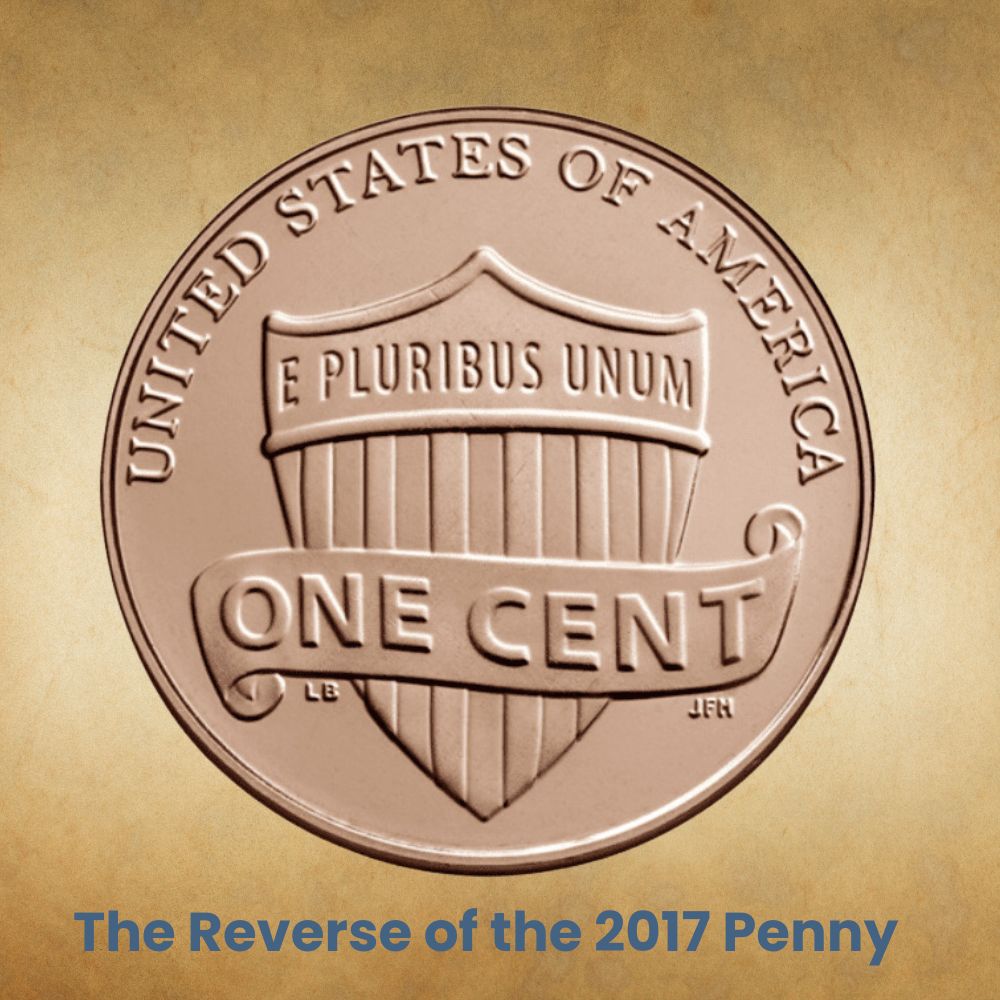
The reverse (tails side) of the 2017 Penny features the Union Shield designed by Lyndall Bass in 2010. The top of the coin reads United States of America while E Pluribus Unum is inside the upper part of the shield. A banner running across the shield bears the denomination, One Cent. The initials LG are under the left side of this banner and JFM is under the right side.
Other Features of the 2017 Penny
The 2017 Penny is 97.5% zinc coated with 2.5% copper to give it that trademark color. This metal composition was introduced in 1982 and is still used today. The coins are 19.05mm in diameter with a plain unreeded edge and they weigh 2.5g each. The US Mint currently uses about 2 cents to mint each penny, but this popular coin has resisted efforts to phase it out.
FAQs About the 2017 Penny
How Much is a 2017 Penny Worth Today?
A 2017 Penny has 2.44g of zinc, and the current spot price of zinc (January 2023) is $0.033 per gram. Since this penny has been around for less than a decade, thousands exist in good condition. So on average, even in MS, a 2017 Penny is only worth its melt value of 3 cents.
What is Special About a 2017-P Penny?
The 2017-P Penny is the only penny ever made that has the P Mint Mark for Philadelphia. In every other year from 1909 to date, Lincoln Pennies from the Philadelphia Mint had no mint marks. And even when other denominations adopted the P in 1979, the penny didn’t get one.

I have a 2017D Lincoln has so many images a man reaching his arm the 0 in 2017 anmimal story lol Lincoln lying across Lincoln magicians soooo many things I haven’t seen them I don’t think I need to information can someone please help me
i have a 2917 P that is weighing in at 2.60g. All my others are 2.5g to 2.52. It is unique and MS grade for sure,